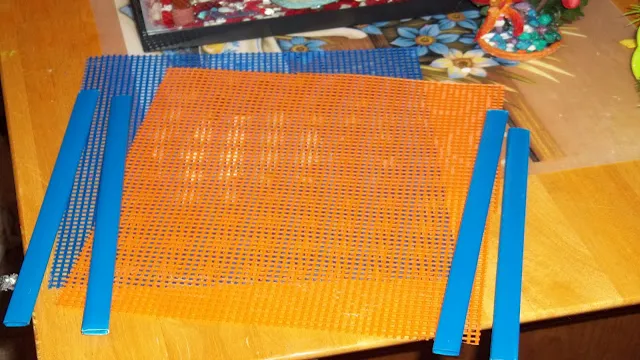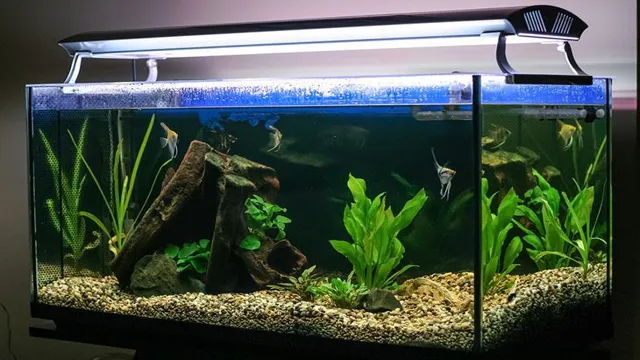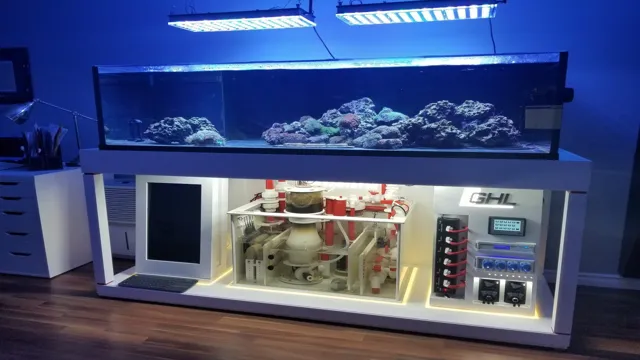Are you tired of your fish tank inhabitants constantly fighting or do you need to separate juvenile fish? A plexiglass aquarium divider may just be the solution! This DIY project is a cost-effective way to create separate areas in your aquarium without purchasing a whole new tank. Plus, it’s quite easy to build and customize based on your tank’s size and your needs. In this blog, we’ll go through all the steps you need to take to create your own plexiglass aquarium divider, so get your tool kit ready and let’s dive in!
Materials Needed
If you’re looking for a cost-effective way to divide your aquarium, you might want to consider using a plexiglass divider. Not only is it much cheaper than buying a pre-made divider, but it’s also customizable to fit the precise dimensions of your tank. To make a plexiglass aquarium divider, you’ll need a few materials such as a sheet of plexiglass, a ruler, a marker or pen, a jigsaw or handsaw, sandpaper, and aquarium safe silicone sealant.
The plexiglass needs to be the right thickness for your tank size, and you can get it from a hardware or home improvement store. Once you have all the materials, you can start measuring and marking your plexiglass sheet to fit your tank’s exact size. Then, using a saw, cut the sheet along the marked lines and sand the edges.
Finally, seal the edges with aquarium safe silicone sealant and let it dry before placing the divider into your tank. With just a few steps, you’ll have a functional and personalized plexiglass aquarium divider.
Acrylic sheet
Acrylic sheet When it comes to working with acrylic sheets, there are a few essential materials that you’ll need to get started. First and foremost, you’ll want to have the acrylic sheet itself! There are a variety of thicknesses and sizes available, so choose the one that best suits your project. In addition to the sheet itself, you’ll also need some basic cutting tools.
A circular saw, jigsaw, or table saw with a fine-toothed blade are all good options for cutting acrylic. However, keep in mind that acrylic sheets can be fragile, so it’s important to use a delicate touch as you cut. You’ll also need a few other basic tools to work with acrylic.
A drill and drill bits are handy for adding holes to your sheet, while a sandpaper block can help smooth any rough edges left from cutting. Finally, if you plan on bending or shaping your acrylic, a heat gun (or oven, in some cases) can help soften the material for easier manipulation. By having these basic materials on hand, you’ll be well-equipped to start working with acrylic sheets and bring your creative projects to life!

Measuring tape
When it comes to measuring for any DIY project, a measuring tape is your go-to tool. It’s an essential item for any homeowner or DIYer to have in their toolkit. Apart from the measuring tape, you’ll need other materials, depending on the task at hand.
For example, when measuring walls, you’ll need a pencil for marking out the measurements, a level for ensuring that the markings are straight and accurate, and possibly a step ladder for reaching the higher points on the wall. When measuring furniture or appliances, a measuring tape is generally enough, but you may need a calculator to convert measurements, depending on your project’s requirements. It’s always best to ensure that you have all the necessary materials before starting any DIY project, so you’re not running back and forth from your toolkit to your project site.
As you progress in your DIY journey, you’ll find that you may need additional tools beyond the basics to improve on the quality of your work.
Marker
Marker If you’re looking to create some colorful art or simply want to doodle, then markers are a great choice for you. All you really need is a set of markers and some paper, and you’re ready to get creative. There are many different types of markers available, including water-based, alcohol-based, and oil-based.
Water-based markers are ideal for use on paper, while alcohol-based markers work well on non-porous surfaces such as plastic or glass. Oil-based markers are better suited for outdoor use due to their resistance to weathering. To get started, you’ll want to select a set of markers in a range of colors.
Most sets come with a variety of colors, from bold and bright to more muted hues. You’ll also want to consider the tip of the marker, as this can affect the type of line and the amount of control you have over the marker. Fine-tip markers are great for precise drawing, while broader tips allow for more expressive strokes.
Once you have your markers, the sky’s the limit. You can create detailed drawings, colorful posters, or even customize clothing and accessories. Whatever your creative outlet may be, markers are a versatile and fun material to work with.
Just let your imagination run wild and see where it takes you!
Straight edge
When it comes to crafting, a straight edge is a must-have tool to achieve precise cuts and measurements. The materials needed for a straight edge depend on the preference of the crafter. Some may opt for a metal straight edge, which is durable and can withstand heavy use.
Others may prefer a clear acrylic straight edge, which allows for easy visibility and accuracy. A wooden straight edge is also an option, providing a more natural feel and aesthetic. Additionally, ruler grips or cork backings can be added to prevent slipping and enhance grip. (See Also: How to Add Drawers to Aquarium Stand: Step-by-Step Guide for Optimal Storage Solution)
It is essential to choose a straight edge that suits your needs and offers the level of accuracy required for your project. Choosing the right materials for your straight edge can make all the difference in creating professional-looking and precise results.
Scissors or saw
When it comes to cutting materials for woodworking, it’s essential to have the right tools. Most people wonder whether they should choose a saw or scissors. The answer largely depends on the material type, as well as the cutting job.
For thinner materials like paper or thin cardboard, scissors are an excellent choice. They offer more control, precision, and are relatively easy to use. On the other hand, saws are ideal for thicker materials like wood or plastic.
They apply more force, and the serrated edge helps grip onto the material better, preventing slipping. Additionally, saws produce straighter and more symmetrical cuts, making them the better option for serious woodworking projects. In conclusion, choosing between scissors or saws depends on the job at hand.
For thin, delicate materials, scissors will do, but for thicker materials, saws are the way to go. Just make sure to choose the right type of saw for the job, such as a handsaw or circular saw, to get the best results possible.
Sandpaper
When it comes to sanding wood or metal surfaces, sandpaper is an essential tool. To start, you will need sandpaper of varying grits, determined by the level of abrasiveness needed for the job. A coarse grit (around 40-60) works best for smoothing rough surfaces, while a finer grit (240 and above) is ideal for polishing and removing finer imperfections.
In addition to sandpaper, you may need a sanding block, which helps to evenly distribute the pressure while sanding. A piece of scrap wood or cardboard can also act as a makeshift sanding block. Dust masks and safety goggles are a must-have to protect yourself from the dust created during the sanding process.
Furthermore, it is essential to choose the right sandpaper for the type of material you are working with. Sandpaper is generally categorized by the type of abrasive used- silicon carbide for harder materials like metal and ceramics, and aluminum oxide is more suitable for wood and plastic. Understanding the material you are working with will help you choose the right type of sandpaper to achieve the desired results.
Overall, using sandpaper may seem like a simple task, but it is crucial to understand the materials needed and how to use them correctly to ensure a flawless finish that lasts. With the right tools and know-how, sanding can transform your materials into a beautiful finished product.
Step-by-Step Instructions
If you’re looking to create a safe and stress-free environment for your aquatic pets, a plexiglass aquarium divider is a great solution. Fortunately, making your own divider is a straightforward project that can be completed with just a few supplies. To get started, measure the length and height of your aquarium and purchase a sheet of plexiglass that matches those dimensions.
Next, use a table saw or circular saw to cut the plexiglass down to size. Once you have the pieces cut, sand down the edges to remove any rough spots. Then, use aquarium-safe silicone to attach the plexiglass pieces together, forming a T-shape that will fit snugly in your tank.
Before adding your divider, make sure to thoroughly clean it to remove any dust or debris. Once installed, your plexiglass aquarium divider will provide a secure and peaceful environment for your aquatic pets to enjoy.
Step 1: Measure the aquarium
If you’ve just picked up a new aquarium, measuring it needs to be your first step before you can begin planning anything else. Measuring the aquarium takes a few minutes, and you’ll need to take accurate measurements so that you can purchase the right-sized equipment. To measure an aquarium, you’ll need a tape measure or ruler.
Begin by measuring the length of the aquarium, from one end to the other. Then, measure the height and width of the aquarium. New aquarium owners often forget to account for the space around the aquarium as well.
Before you begin planning where to put your aquarium, it’s crucial to measure the entire area where you want to place it, including any shelves, cabinets, or stands. By measuring your aquarium carefully, you’ll avoid purchasing the wrong-sized products and ensure that your aquarium looks its best.
Step 2: Cut the acrylic sheet
Now that you have all the necessary tools and materials set up, it’s time to cut the acrylic sheet for your DIY project. Before you start, make sure to measure the sheet accurately and mark the cutting line. For the actual cutting, you can use a jigsaw or circular saw with a fine-toothed blade suitable for cutting plastics.
Cut slowly and cautiously while holding the sheet firmly in place to avoid cracking or breaking. As you cut, make sure to wear safety gloves and goggles for added protection. It can also be helpful to place the sheet on a supportive rubber mat or foam to prevent damage. (See Also: How Soon Will Microne Lift Special Blend Affect Aquarium Water: Expert Analysis)
Once you have cut along the line, use sandpaper to smooth out any rough edges. With some patience and attention to detail, you’ll have a perfectly cut acrylic sheet for your project.
Step 3: Sand the edges
Now that you’ve cut and shaped your wood into the desired design, it’s time to move on to the next step: sanding the edges. This is an important step to ensure that your finished product looks smooth and professional. Begin by using a medium grit sandpaper and sand the edges in long, even strokes.
Be sure to keep the sandpaper flat against the wood to avoid creating any rough spots or indentations. After you’ve gone over the edges with the medium grit, switch to a fine grit sandpaper and repeat the process. This will help to get rid of any remaining roughness and create a beautiful, polished finish.
Remember to sand evenly and take your time to get the best results. With these easy steps, your woodworking project will be looking better than ever in no time!
Step 4: Mark the divider placement
Now that you have your drawer divided, it’s time to mark the placement of the dividers. This step is crucial to ensure that your drawer will be organized properly. Start by measuring the height of the drawer and divide it by the number of dividers you want to place.
This will give you the distance between each divider. Using a pencil, mark the placement of each divider along the sides of the drawer. Make sure to measure twice and mark once to avoid any mistakes.
Once you have all the divider placements marked, you are ready to move on to the next step, which involves installing the dividers. By following these step-by-step instructions, you can be sure that your drawer will be perfectly organized and clutter-free.
Step 5: Attach the divider
Now that the sides and bottom of your DIY drawer are secure, it’s time to attach the divider. This step is important because it helps you organize your drawer and keep everything in its place. First, measure the distance between the two sides of the drawer and cut your piece of wood to fit.
Then, use wood glue and clamps to attach the divider to the bottom of the drawer. Allow it to dry completely before continuing any further. Now you have two compartments in your DIY drawer, perfect for storing smaller items such as socks, underwear, or office supplies.
Take your time with this step and make sure it’s done correctly – you don’t want your divider to come loose!
Tips for Success
Making your own plexiglass aquarium divider can be a cost-effective and easy way to separate your fish and ensure their safety. To get started, make sure you have all the necessary tools and materials, including a plexiglass sheet, a ruler, a pencil, a drill, and some aquarium silicone. Begin by measuring the dimensions of your aquarium and determine the size of your divider.
Once you have the measurements, carefully cut the plexiglass sheet to the desired size using a circular saw or a jigsaw. Next, use the drill to make small holes along the edges of the divider to allow water flow between compartments. Apply a generous amount of aquarium silicone to the edges of the divider, and carefully place it into your aquarium.
After allowing the silicone to cure, your fish will be able to swim safely on either side of the divider, while still being able to see each other. With a little bit of care and attention, making your own plexiglass aquarium divider can be a fun and rewarding DIY project that benefits both you and your aquatic pets.
Use a straight edge for accurate cuts
If you’re having trouble getting straight, accurate cuts for your DIY projects, then using a straight edge can be a game-changer. A straight edge is a tool that is designed to help you achieve precision when cutting materials like wood, metal, or plastic. It works by providing a straight, flat surface against which you can press your cutting tool to create perfectly straight and even cuts.
By using a straight edge, you can eliminate the guesswork and unevenness that often results from freehand cutting. To use a straight edge, simply place it on your material, align it with the desired cutting line, and then hold it firmly in place while you make your cut. It’s a simple but effective technique that can make a big difference in the quality of your cuts.
So the next time you need to make precise cuts, don’t underestimate the power of a straight edge! (See Also: How to Clean a Tower Aquarium: 5 Steps to Keep Your Aquatic World Sparkling Clean)
Sand the edges to prevent injury to fish
When setting up a new fish tank, it’s essential to take every precaution to ensure the safety and well-being of your swimming friends. One crucial step that is often overlooked is sanding the edges of any decorations or accessories in the tank. These items can have rough edges that can injure your fish, causing serious harm or even death.
While it may seem like a small detail, sanding down the edges can make a significant difference in your fish’s overall health and happiness. So, before adding any decor to your tank, take the time to sand down any sharp edges and ensure a safe and comfortable environment for your aquatic pets. Keyword: Fish tank safety.
Make sure the divider is firmly attached to the aquarium
When setting up a divider in your aquarium, it’s important to make sure it’s firmly attached to the tank to prevent any accidents or mishaps down the line. This can be especially crucial if you’re keeping multiple fish species together that don’t get along, or if you’re trying to quarantine a sick fish from the rest of your aquatic pets. To ensure success, consider the size and material of the divider you’re using, and use suction cups or clips to securely fasten it in place.
You may also want to add some extra support, such as a small piece of Velcro or tie wrap, to give added stability and prevent the divider from shifting. By following these simple tips, you can help provide a safe and stress-free environment for all your fishy friends. So go ahead, give it a try, and watch as your aquarium flourishes with life!
Conclusion
In conclusion, making your own plexiglass aquarium divider is a DIY project that proves to be both practical and aesthetically pleasing. With a little bit of creativity and some careful planning, you can customize your own divider to fit the exact dimensions of your tank, enhancing the overall look and functionality of your aquarium. So, whether you’re looking to keep your fish separated or just want to add an extra touch of flair to your tank, making a plexiglass aquarium divider is an easy and rewarding endeavor that any fish enthusiast can accomplish.
“
FAQs
What is plexiglass and why is it used for aquarium dividers?
Plexiglass is a type of acrylic plastic that is popular for aquarium dividers due to its clarity, strength, and ease of customization.
How thick should plexiglass be for an aquarium divider?
The thickness of plexiglass for an aquarium divider will depend on the size and height of the aquarium. As a general rule, thicker plexiglass (1/4 inch or more) is better for taller or larger aquariums to prevent bowing or cracking.
Can plexiglass aquarium dividers be cut to fit specific aquariums?
Yes, plexiglass aquarium dividers can be easily cut with a saw or specialized cutting tool to fit the exact dimensions of your aquarium.
Is it difficult to install a plexiglass aquarium divider?
Installation of a plexiglass aquarium divider is relatively simple and can be accomplished with aquarium-safe silicone sealant and suction cups or a specialized divider bracket.
Can a plexiglass aquarium divider be removed without damaging the aquarium?
Yes, a plexiglass aquarium divider can be removed without damaging the aquarium if installed correctly and removed carefully to avoid scraping the silicone sealant.
Are there any downsides to using a plexiglass aquarium divider?
While plexiglass is a great material for aquarium dividers, it may warp or discolor over time if exposed to direct sunlight or high temperatures. It is important to avoid cleaning plexiglass with abrasive materials to prevent scratches.
Can a plexiglass aquarium divider be used in a saltwater aquarium?
Yes, plexiglass aquarium dividers can be used in both freshwater and saltwater aquariums. However, it is important to choose a plexiglass material that is safe for use with marine life and resistant to salt damage.







